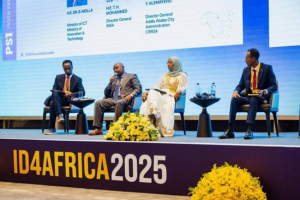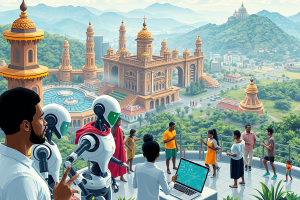
Data from United Nations High Commissioner for Refugees (UNHCR) shows that over 100 million people across the world are forcibly displaced from their homes and found shelter in different refugee camps. The UNHCR attempts to provide various services such as access to education, healthcare and other basic services.
The agency also believes that refugees shouldn’t be left behind in a digital world. Digital inclusion and connectivity is very signficant as it makes refugees informed about the world, follow their classes online and be connected with their families.
Accordingly, the agency along with International Telecommunication Union (ITU) and Groupe Speciale Mobile Association (GSMA) is seeking to ensure all major refugee hosting areas have available and affordable connectivity by 2030, advancing the digital inclusion of over 20 million forcibly displaced people and local host communities.
ITU’s Secretary General, Doreen Bogdan- Martin, and UNHCR’s Deputy High Commissioner, Kelly T. Clements paid a visit to Ethiopia this week and held discussion with Ethiopian government officials on the state of refugees sheltred in Ethiopia. On the course of discussion, Ethiopian Innovation and Technology Minister Belete Molla (PhD) highlighted activities needed and support his ministry demand to improve the digital access of refugees and the host communities.
He said the digitalization is significant for refugees to get online education, use mobile banking and mobile money, have digital job opportunities and acquire other technological skills. Belete Molla (PhD) reaffirms Ethiopia’s commitment to supporting refugees with all its capacities. “Ethiopia will jointly work with all stakeholders to realize the refugee digital inclusion initiative. All stakeholders mainly ITU should strengthen their support in realizing the initiative in Ethiopia.”
According to the Minister, parallel to implementing digital connectivity and inclusion of refugees, stakeholders should consider supporting the Ethiopian Government’s initiative of improving the capacity of schools in refugee areas. He calls on ITU to support Ethiopia’s project proposal “Connect and Recover” Initiative that is already sent to the union.
Heads of ITU and UNHCR witnessed how digital connectivity is providing a lifeline and solutions for refugees and displaced people, helping them access mobile money, online health services, connected education and as an avenue to employment in the digital economy. UNHCR’s Deputy High Commissioner Kelly T. Clements said that “Today in Ethiopia we’ve heard first-hand from refugee communities how much digital technology means to them, as crucial to their self-reliance and a way to connect to key services as well as loved ones. Many challenges remain. We must find affordable ways to connect the many forcibly displaced people who are still out of reach.”
ITU’s Secretary General, Doreen Bogdan- Martin after visited a refugee camp in Ethiopia said that “In Ethiopia, we have witnessed the ingenuity of refugee communities in finding whatever path they can to stay connected with society. These communities are asking all stakeholders to do their bit to expand access to meaningful connectivity so that they can enjoy a safe, satisfying, enriching and productive online experience at an affordable cost.”
Ethiopia is among leading countries that host large number of refugee population in the world. In fact, it hosts close to a million refugees making it the top refugee host in in Africa. Ethiopia is active campainger for refugees right as it propsed the initiative of refugee inclusion initiative that provide refugees basic social services and integration with host communities. The program to incorporate more than 20 million refugees’ in digital world demand at least USD 20 million in core support and USD 200 million in direct investment.
Though at infancy stage, the refugee digital inclusion and connectivity initiative is creditable beginning to improve the livelihoods of refugees and strength their social connectivity with their relatives and the world. The initiative of refugee connectivity seeks policy commitments of governments and infrastructural investments involving of all stakeholders.
As mentioned above, refugees need beyond temporary support for their daily consumption. Promoting education including online educations and other digital services should be considered to support refugees’ resilience and self-reliance. In technologically developed world where economic and social activities are continued to run through digital technology, access to digital technology is a not an extra or luxury.
It is difficult to promote digital inclusion and connectivity leaving behind over 20 million refugees. The recent years’ activities of United Nations Higher Commission for Refugees (UNHCR) and other international organization’s jointly with governments’ of host countries to promote inclusion of refugees with the host communities is opening opportunities for refugees to get social services, job opportunities and other basic services from the community they are residing.
The refugee inclusion service is now developing to refugee digital inclusion with the goal of connecting refugees with digital services. The UNHCR and the International Telecommunications Union (ITU) and GSMA have developed an ambitious pledge around refugee connectivity that seeks to mobilize investments and further policy commitments to include refugees in national frameworks and objectives around digital access for all through universal connectivity. This includes fostering an enabling policy and regulatory environment for both expansions of infrastructure and lifting regulatory barriers to individual access for displaced people.
The partners aim to lay the foundation for advancing meaningful connectivity as both a community need and a cornerstone of digital transformation in the humanitarian sector. Driven by data, promising practices and through piloting new business models, the partners aim to devise pathways for new sustainable solutions to get displaced communities online.
They issued an urgent global call to action to increase investment and establish an enabling regulatory framework for providing connectivity to forcibly displaced and stateless people and the communities that host them. A joint letter signed in 2021 between the two agencies outlined a shared vision of a connected society that leaves no one behind, in line with the Sustainable Development Goals.
BY DARGIE KAHSAY
THE ETHIOPIAN HERALD 7 JULY 2023




